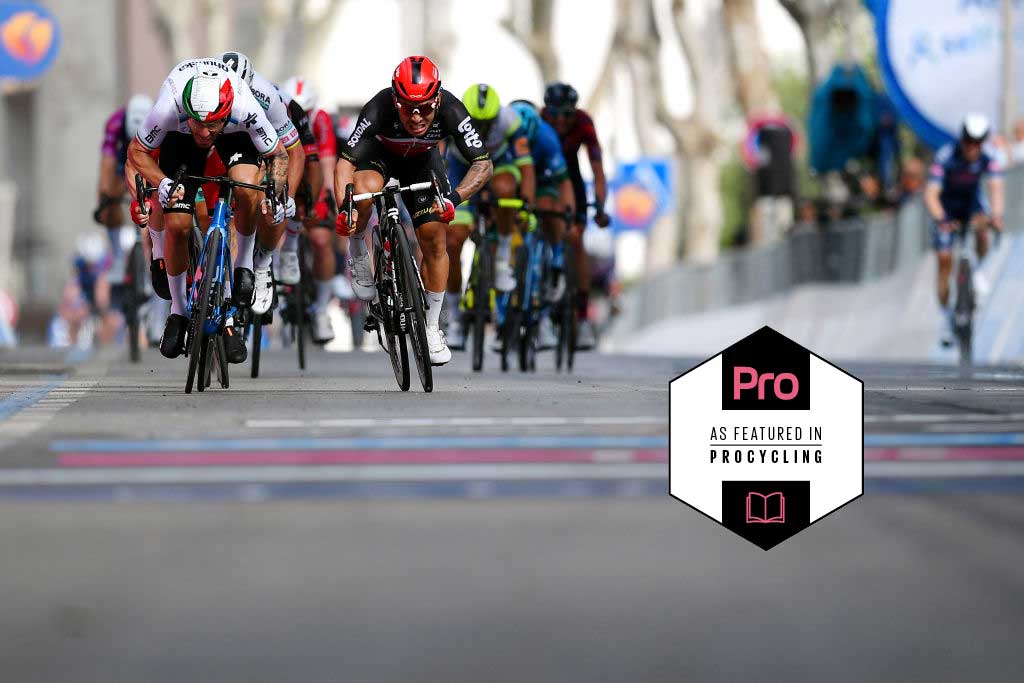Giro d'Italia stage 5 analysis: Concentrated action
When one of the quietest days packs all the action into the final kilometres

One must, the 19th century French political author Germaine de Staël observed, choose in life between boredom and suffering. It’s a dichotomy that is familiar to the riders of a Grand Tour; just as much so to those who follow cycling on television.
Grand Tours are endurance events and we think that what the riders most have to endure is physical discomfort. This discomfort arises at various points in the race from pedalling hard, or from pedalling for a long time; sometimes the two happen in conjunction.
But mental endurance is as important a part of a Grand Tour as the physical. And like the physical stress, the mental stress is sometimes long and drawn out – boredom in other words – or intense and frazzling.
Stage 5 of the 2021 Giro d’Italia was a case in point. For long, long hours the peloton traced the diagonal northwest-to-southeast line which connected the start in Modena and the finish on the Adriatic coast in Cattolica. The flatlining profile, with nary a hill nor a gust of wind in the right direction to split the bunch, was a convenient metaphor for the dearth of action in the four hours it took to get to the coast.
Not much happened for most of the day. Certainly nothing happened that had any effect or influence on the final outcome of the stage. An Androni and a Bardiani rider attacked, surely out of muscle memory rather than ambition. Their lead described a perfect parabolic arc – it went out, stretched to five minutes and then came back in again as the peloton caught them without really trying.
The problem is that the teams of the sprinters, who were caught out on stage 3, know that a break of more than four riders will be hard to bring back so they don’t allow more than four in the break, which means riders don’t even try in the first place. If more than four try they won’t be allowed away and therefore won’t win. If fewer than four try, they also won’t win. Another Androni and Bardiani rider attacked and were joined by Alexis Gougeard of AG2R Citroën. Tangible effect on the outcome of the race: zero.
But a run-in which alternated roads wide enough to accommodate a 20-rider-wide peloton and narrow corners which drew the bunch out to single file made the last 15 kilometres fraught and dangerous. Pavel Sivakov (Ineos Grenadiers) got squeezed into a tree whose branches overhung the road and crashed heavily.
Get The Leadout Newsletter
The latest race content, interviews, features, reviews and expert buying guides, direct to your inbox!
There was a crash on a narrow corner with 9 kilometres to go. Yesterday’s stage winner Joe Dombrowski (UAE Team Emirates) and Mikel Landa (Bahrain Victorious) both came down very heavily in a crash involving a piece of road furniture and a marshall.
Landa never made it to the finish and is out of the race after looking the most aggressive and floaty of the GC favourites on the uphill finish in Sestola. Dombrowski limped in minutes down and was taken to hospital – he had a realistic chance of taking the pink jersey on the uphill finish on stage 6 tomorrow but his future in the race now hangs in the balance.
Even the sprint finish was messy and dangerous. Juan Sebastian Molano, leading out for UAE Team Emirates, started freewheeling and drifting across the road while looking backwards and the sprinters were forced to weave around him. Peter Sagan (Bora Hansgrohe), Tim Merlier (Alpecin-Fenix) and eventual winner Caleb Ewan (Lotto Soudal) had a wobbly moment as they came together, with the Belgian baulked in the incident.
That’s cycling. It was easily the most boring day’s racing we’ve seen in 2021 yet by the end of the stage Dombrowski, the King of the Mountains and yesterday’s winner, went from the finish to the hospital after losing several minutes and Landa, a possible overall winner, was out of the race. Sivakov, a previous top-10 finisher who was a very plausible plan B for Ineos Grenadiers, lost 13 minutes and later abandoned altogether. Nothing happened and then everything happened.
When Madame De Staël wrote her portentous words about boredom and suffering, the unspoken subtext was that one was as undesirable as the other. The riders of the 2021 Giro might disagree.
Edward Pickering is Procycling magazine's editor.
Procycling magazine: the best writing and photography from inside the world's toughest sport. Pick up your copy now in all good newsagents and supermarkets, or get a Procycling subscription.
Edward Pickering is Procycling magazine's editor. He graduated in French and Art History from Leeds University and spent three years teaching English in Japan before returning to do a postgraduate diploma in magazine journalism at Harlow College, Essex. He did a two-week internship at Cycling Weekly in late 2001 and didn't leave until 11 years later, by which time he was Cycle Sport magazine's deputy editor. After two years as a freelance writer, he joined Procycling as editor in 2015. He is the author of The Race Against Time, The Yellow Jersey Club and Ronde, and he spends his spare time running, playing the piano and playing taiko drums.